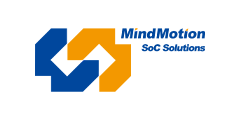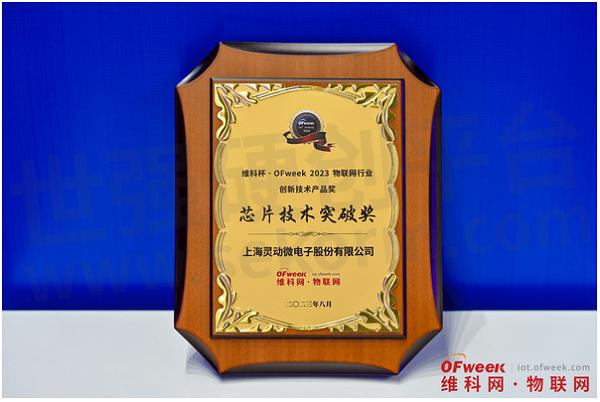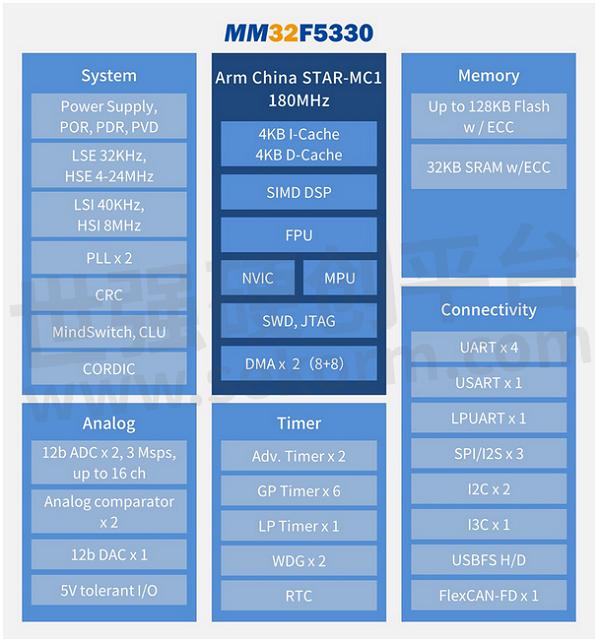MindMotion MM32F5330 Microcontroller Honored with “OFweek 2023 IoT Industry Innovation Technology Product Award“

On August 28th, at the "OFweek 2023 (8th Edition) IoT Industry Conference", which is also known as the "OFweek IoT Industry Annual Awards", MindMotion's MM32F5330 was honored with the " OFweek 2023 IoT Industry Innovation Technology Product Award - Chip Technology Breakthrough."

As the IoT platform continues to grow rapidly, and service support capabilities improve, new technologies such as edge computing and artificial intelligence are continuously integrated into the IoT. Power consumption and efficiency of microcontrollers have always been a focal point in the industry.
In the OFweek IoT Industry Annual Awards, after intense competition through multiple rounds of evaluation by OFweek, MindMotion's MM32F5330, with its innovation and outstanding performance, ultimately received the Chip Technology Breakthrough Award.

The MindMotion MM32F5330 microcontroller is equipped with the Armv8-M architecture "Star-MC1" core, authorized by Arm China. It boasts a performance improvement of nearly 20% compared to traditional Cortex-M3/M4 processors. Its Coremark score of 4.02 ranks among the top in the MCU domain based on Arm architecture. In terms of system architecture, MM32F5 offers higher system-level concurrency through advanced memory structures such as independent Cache and TCM. The MM32F5330 operates at a maximum clock frequency of 180MHz, equivalent to over 200MHz in Cortex-M4-based MCUs. Its built-in 128KB Flash, 32KB SRAM, 4KB L1 instruction cache, and 4KB L1 data cache significantly enhance code execution efficiency.

Key Features of MM32F5330
Core and System
Operating frequency up to 180MHz
Features the 32-bit Armv8-M "Star-MC1" core architecture by Ambiq Technology, with built-in single-precision floating-point unit (FPU) and DSP extensions
4KB L1 instruction cache (I-Cache) and 4KB L1 data cache (D-Cache)
Trigonometric Acceleration Unit (CORDIC) supporting Sin, Cos, and Atan operations
MindSwitch peripheral interconnect matrix, enabling direct connections or trigger connections between modules like timers, GPIOs, EXTI, ADC, DAC, and comparators
2 8-channel DMA controllers supporting various peripherals including timers, ADC, DAC, UART, LPUART, I2C, I3C, SPI, and FlexCAN-FD
Memory
Up to 128KB of Flash memory
Up to 32KB of SRAM
Bootloader supports in-system programming (ISP) of on-chip Flash
Clock, Reset, and Power Management
Operating voltage range: 1.8V to 5.5V
Power-on/reset (POR/PDR), undervoltage reset/programmable voltage monitor (BOR/PVD)
External 4-24MHz high-speed crystal oscillator
Built-in factory-calibrated 8MHz high-speed RC oscillator
Built-in PLL1 generating system clocks, supporting various division modes for bus matrix and peripheral clocks
Built-in PLL2 generating a maximum 100MHz system clock, supporting various division modes, providing clocks for USB, FlexCAN-FD, and ADC
Built-in 40KHz low-speed oscillator
External 32.768KHz low-speed oscillator with bypass capability
Low Power
Various low-power modes, including Lower Power Run, Sleep, Low Power Sleep, Stop, Deep Stop, and Standby
VBAT supplies power to RTC and backup registers (20 x 16-bit)
Up to 14 Communication Interfaces
4 UART interfaces
1 USART interface
1 LPUART interface
2 I2C interfaces
1 I3C interface
3 SPI interfaces
1 USB 2.0 full-speed Device/Host controller with built-in PHY
1 FlexCAN-FD interface, compatible with CAN 2.0B and CAN-FD protocols
13 Timers
2 16-bit 4-channel advanced timers (TIM1 / TIM8), each channel with 2 PWM outputs, including 1 complementary output with 4-channel PWM output, and support for hardware dead-time insertion and emergency stop function after fault detection
2 16-bit 4-channel general-purpose timers (TIM3 / TIM4) and 2 32-bit 4-channel general-purpose timers (TIM2 / TIM5), each channel with 1 PWM output, and support for input capture and output compare, suitable for decoding infrared, Hall sensor, or encoder signals
2 16-bit basic timers (TIM6 / TIM7) that can be used for general timing and generating interrupts
1 16-bit low-power timer (LPTIM) capable of waking up the processor in all low-power modes except Standby
2 watchdog timers, including the independent IWDG and windowed WWDG
1 24-bit Systick timer
1 RTC real-time clock
2 12-bit ADCs, supporting a total of 16 external input channels and 2 internal input channels, with each ADC supporting a maximum conversion rate of up to 3MSPS and hardware support for oversampling up to 16-bit resolution
Conversion range: 0 to VDDA
Supports sampling time and resolution configuration
Supports hardware oversampling, with oversampling options ranging from 2 to 256 times
On-chip temperature sensor
On-chip voltage sensor
VBAT voltage sensor
1 12-bit DAC
2 high-speed analog comparators
Up to 49 fast I/O ports
All I/O ports can be mapped to 16 external interrupts
All ports can input and output signals with voltages not exceeding VDD
Up to 28 5V-tolerant I/O ports
CRC calculation unit
96-bit unique chip ID (UID)
Debugging modes
Serial Wire Debug (SWD) interface
JTAG interface
Available in LQFP64, LQFP48, and QFN32 packages
Full series supports an extended industrial operating temperature range of -40℃to +105℃
- +1 Like
- Add to Favorites
Recommend
- “MindMotion·Star“ Series: Major Member MM32F5260 Officially in Mass Production
- New Milestone! Following the Success of MM32G0001, MindMotion Launches the Next-Level, High-Value MCU – MM32F0120
- The “MindMotion·Star” Series MM32 High-performance MCU Products Based on the Arm China Star-MC1 Core
- MindMotion Launches the Innovative MM32G Series MCU Features a Span from Cortex-M0 Core to STAR-MC1 Core
- MindMotion Announces the New MM32F0160 Series of MCUs Equipping with a 72MHz Arm® Cortex®-M0 Processor
- MindMotion Launches High-performance MM32F5 Series MCU with STAR-MC1 as the Core
- MindMotion Announced Entry-level MM32G0001 32-bit MCU Equipping with a 48MHz Arm® Cortex®-M0 core
- MindMotion‘s MCU MM32F5270 Wins the Honors of “2022 World Electronics Achievement Awards”
This document is provided by Sekorm Platform for VIP exclusive service. The copyright is owned by Sekorm. Without authorization, any medias, websites or individual are not allowed to reprint. When authorizing the reprint, the link of www.sekorm.com must be indicated.






























































































































































































































































































































































































































































































































































































































































































































































































































































































